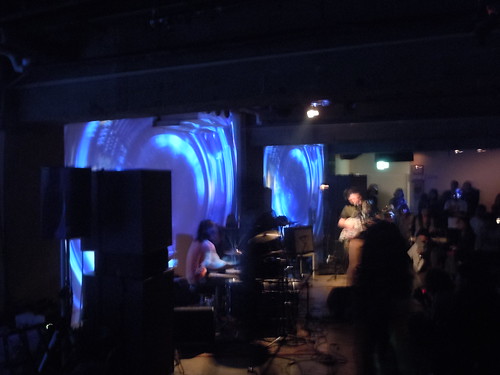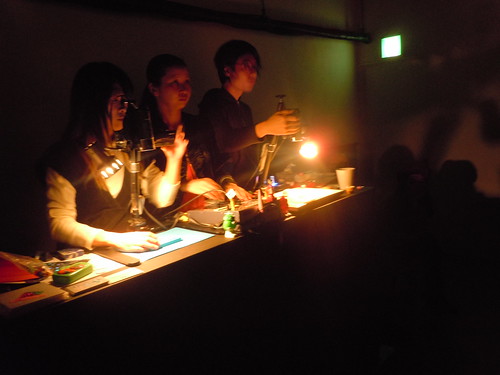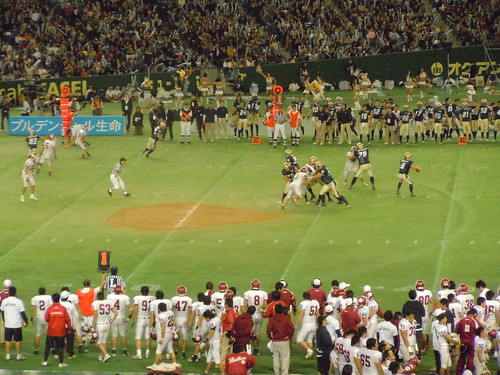I sat down for a few minutes yesterday to talk with Yamaan, a producer affiliated with the Temple-ATS experimental hip hop crew, about his new album, 12 Seasonal Music. Yamaan has produced tracks for several Temple artists, as well as friendly artists Juswanna and Chiyori, a reggae/soul singer affiliated with the Mary Joy label. Chiyori actually joined us, as she did a couple of years ago when I first talked to Yamaan, partly because she's on the new album, and partly because she happens to be his girlfriend. There's going to be a more polished version of all of this going up at Tinymixtapes sooner or later, but I wanted to pass along some of the interesting tidbits from the interview, including info on Temple's history, the similarities between blues and ambient music, what draws a Japanese teenager from Yamanashi-Ken to Tokyo, and what it's like to grow up in a city built from the ground up for scientific research.
But first, here's "Sea," the album's summery 7th track:
The track reflects Yamaan's nostalgic, generally pretty sound - which is frankly a little strange considering where he comes from.
Tuesday, January 18, 2011
Sunday, January 16, 2011
Taboo1 and Shibito - Gindan no Wakusei [Forbidden Planet]
This is the lead single from Taboo1's Lifestyle Masta LP, which came out in October. I hadn't seen this before, but between the mind-bending video and great track, including some super-advanced style from Shibito, it's a must-check.
Saturday, January 15, 2011
I'll Give You Something to Remember Like the Alamo.
I've been on a crude version of it for over a year now, but to celebrate the release of the book (and its treasure trove of new detailed tips), I'm renewing my commitment to Tim Ferris's 4 Hour Body /Slow Carb eating program. Maybe I'll post more about that sometime, but today is my favorite part - the "eat whatever the hell you feel like" day. I've had a crepe, two sodas, a donut, a Zats burger, a Snickers, and now, before I hit the sack, the piece de resistance - a grab bag of burgers from McDonald's.
/Slow Carb eating program. Maybe I'll post more about that sometime, but today is my favorite part - the "eat whatever the hell you feel like" day. I've had a crepe, two sodas, a donut, a Zats burger, a Snickers, and now, before I hit the sack, the piece de resistance - a grab bag of burgers from McDonald's.
Don't look at me like that.
Anyway, McDonald's Japan has just revived its "Big America" campaign, featuring four different regional flavors. First up is the Texas Burger, and it's an unmitigated disaster. (A few years ago this would have been predictable, but McDonald's food has been getting much better). Sadly the Texas2 Burger is ruined by the Japanese influence. Rather than Jalapenos, I think the spiciness comes mainly from horseradish mustard, the chili-esque substance slathered on it is nuclear red, and there's what is, I think, a piece of ham on it? But it's supposed to be bacon? I don't know. But it does not even remotely remind me of home.
P.S. - Testing out some Amazon linking options here . . .
Don't look at me like that.
Anyway, McDonald's Japan has just revived its "Big America" campaign, featuring four different regional flavors. First up is the Texas Burger, and it's an unmitigated disaster. (A few years ago this would have been predictable, but McDonald's food has been getting much better). Sadly the Texas2 Burger is ruined by the Japanese influence. Rather than Jalapenos, I think the spiciness comes mainly from horseradish mustard, the chili-esque substance slathered on it is nuclear red, and there's what is, I think, a piece of ham on it? But it's supposed to be bacon? I don't know. But it does not even remotely remind me of home.
P.S. - Testing out some Amazon linking options here . . .
Friday, January 14, 2011
Minds in Bodies and Bodies in Mind
I've spent the last three or four years in a strange sort of denial. I can't remember exactly when it started, because it was an experience I didn't have much frame of reference for, but every fall recently has brought a set of subtle but insidious symptoms, worst of which was a fatigue that cut my energy levels to about 70% - enough to slow me down severely, but not, it turned out, enough to stop me in my tracks long enough to seriously reflect on what was going on. What I ended up doing was confusing my physical state for a mental condition - I thought, during these stretches, that I was 'coming down with' depression, after years of being pretty much an Energizer Bunny of positivity and accomplishment. Last year in particular, the fall involved juggling two or three different jobs while trying to finish my dissertation and searching for a job, and fatigue and anxiety seemed only natural.
This fall was a different story, but also the same story. As some of you know I'm currently a research fellow, which leaves me with a lot of time - but this fall I found it desperately difficult to make use of it, even after my initial settling-in period here in Tokyo had passed. I was unfocused, and didn't set about getting interviews and other ethnographic work together with my usual single-mindedness. I started, again, feeling bad about myself as a person, berating myself for running out of energy before my usual late-night fieldwork got underway. At the same time, I was aware that at least part of the problem was that I was physically not at my best. The one thing I had been able to be objective about the previous falls was a series of sinus infections and colds, and again, this time around, I took some cold pills and antihistamines, but they didn't really do the trick. I basically soldiered on, and fell further and further out of touch with a sense of myself as capable of accomplishing anything with the huge gift of time I'd been given.
Then, two weeks ago, I learned the hard way that antihistamines and pseudoephedrine didn't mix well with even moderate drinking.
This fall was a different story, but also the same story. As some of you know I'm currently a research fellow, which leaves me with a lot of time - but this fall I found it desperately difficult to make use of it, even after my initial settling-in period here in Tokyo had passed. I was unfocused, and didn't set about getting interviews and other ethnographic work together with my usual single-mindedness. I started, again, feeling bad about myself as a person, berating myself for running out of energy before my usual late-night fieldwork got underway. At the same time, I was aware that at least part of the problem was that I was physically not at my best. The one thing I had been able to be objective about the previous falls was a series of sinus infections and colds, and again, this time around, I took some cold pills and antihistamines, but they didn't really do the trick. I basically soldiered on, and fell further and further out of touch with a sense of myself as capable of accomplishing anything with the huge gift of time I'd been given.
Then, two weeks ago, I learned the hard way that antihistamines and pseudoephedrine didn't mix well with even moderate drinking.
Sunday, January 9, 2011
Superdeluxe: Tokyo's Experimental Music Heaven
Last night I got out to Superdeluxe, Tokyo's biggest venue for experimental/progressive music, for what was unbelievably the first time. Remember, I moved here from Iowa City, where there is a healthy, but still quite small and institutionally homeless experimental music scene. In Tokyo, what you get is this:

The various spazzy bands last night played in front of a triple-projector setup, between two sweet-sounding stacks. The video, moreover, was being produced and mixed live by this great trio of performers:

There was also great, live-control lighting, great seating, friendly crowd . . . and this is a free monthly event. I loved the tight-knitness of Iowa City, and there were some really gifted musicians there, but this is on a whole other level. I have honestly gotten a little jaded about Tokyo a bit too quickly, probably because I've been so purely focused on my research that I've not seen quite enough of what the city has to offer - but this was a real mind-bender. Remember, I'm used to seeing weird music in people's basements, standing next to old paint cans, drinking forties out of paper bags.
But man, this is Tokyo.
(Oh, and the bands were great too. Stephane Shibatsuji-Perrin really showed up on the hacked light-sensor toy guitar.)

The various spazzy bands last night played in front of a triple-projector setup, between two sweet-sounding stacks. The video, moreover, was being produced and mixed live by this great trio of performers:

There was also great, live-control lighting, great seating, friendly crowd . . . and this is a free monthly event. I loved the tight-knitness of Iowa City, and there were some really gifted musicians there, but this is on a whole other level. I have honestly gotten a little jaded about Tokyo a bit too quickly, probably because I've been so purely focused on my research that I've not seen quite enough of what the city has to offer - but this was a real mind-bender. Remember, I'm used to seeing weird music in people's basements, standing next to old paint cans, drinking forties out of paper bags.
But man, this is Tokyo.
(Oh, and the bands were great too. Stephane Shibatsuji-Perrin really showed up on the hacked light-sensor toy guitar.)
Saturday, January 8, 2011
"Transformation" at Tokyo Museum of Contemporary Art: Bio-Viewing
I spent about four hours yesterday cruising through the TMOCA exhibit "Transformations," which is ending a the end of this month. It's absolutely essential for anyone with an interest in art, and likely important for anyone who thinks seriously about the show's particular themes - the status of humans in an era of advancing biotechnology. The exhibit deals with things like genetic engineering and artificial limbs, but also more abstract ideas of transformation. It's so full of amazing stuff I didn't have time to fully absorb all of it, much less the energy to keep going to the current display from the permanent collection, so I plan to go again soon.
It's an amazing museum and this exhibit is not to be missed - but there are definitely some problems. The biggest head-scratcher was that Matthew Barney's Cremaster 3 is being shown in its entirety on two small LCD screens suspended above an installation, in a gallery room full of film stills. Since the film is still impossible to legally see outside of a museum, this leaves the option of standing for an hour and a half, or sitting against a wall. On top of that, since it's showing in a fully lit gallery instead of a screening room, parts of the occasionally very dark film are just hard to see. Especially since so much space was given to other films, this seems crazy. I can only think of two explanations - either there was an assumption that people have already seen Cremaster 3 and only needed a refresher, or Barney didn't agree to a full-scale screening as part of his broader tendency to limit access to the work.
More generally, though, there were just too many films, which led both to viewing fatigue and, worst of all, some sound bleed - particularly in one section where Sputniko!'s techno-pumping installation threatened to break the suspension of disbelief fostered by Masakatsu Takagi's enthralling Ymene. That work still managed to be the show's greatest discovery for me - conceived as a "bird's-eye-view" video, it uses video manipulation techniques that are completely impossible to describe, and has the visceral impact of a roller coaster ride. It's mind-bending in the best possible way, and absolutely worth experiencing even in somewhat compromised conditions.
Other highlights included Jan Fabre's amazing self-portrait busts, in which he molds horns of real-life species onto his own head, Lee Bul's somehow acutely Asian robots, and Patricia Piccini's deeply uncanny short about a mermaid. I'm late enough getting to this show I can't justify a full writeup, but suffice it to say, if you live in Tokyo or will be here in the next few weeks, you owe it to yourself to go.
It's an amazing museum and this exhibit is not to be missed - but there are definitely some problems. The biggest head-scratcher was that Matthew Barney's Cremaster 3 is being shown in its entirety on two small LCD screens suspended above an installation, in a gallery room full of film stills. Since the film is still impossible to legally see outside of a museum, this leaves the option of standing for an hour and a half, or sitting against a wall. On top of that, since it's showing in a fully lit gallery instead of a screening room, parts of the occasionally very dark film are just hard to see. Especially since so much space was given to other films, this seems crazy. I can only think of two explanations - either there was an assumption that people have already seen Cremaster 3 and only needed a refresher, or Barney didn't agree to a full-scale screening as part of his broader tendency to limit access to the work.
 |
| Masakatsu Takagi |
Other highlights included Jan Fabre's amazing self-portrait busts, in which he molds horns of real-life species onto his own head, Lee Bul's somehow acutely Asian robots, and Patricia Piccini's deeply uncanny short about a mermaid. I'm late enough getting to this show I can't justify a full writeup, but suffice it to say, if you live in Tokyo or will be here in the next few weeks, you owe it to yourself to go.
Tuesday, January 4, 2011
Gridiron Japan: Rice Bowl 2011
On Monday, I got out to the Rice Bowl - the final match in Japan's American Football season. It's a pretty odd setup, pitting the champions of the professional, company-sponsored X-League (Japanese) against the collegiate champions. This year, the Obic Seagulls won the X-Bowl, and with it the right to face off against the Ritsumeikan University Panthers. Despite this weird setup, the Rice Bowl is referred to as the Japanese national championship in American Football.

The history of American football (Japanese) in Japan is surprisingly long, going back to the 1936 founding of three university teams. The game is now amazingly vital at the university level here, with particular strength at the most elite universities, including Tokyo, Meiji, and Waseda Universities. I can't really speak for the country as a whole, but Tokyo has quite a few sports bars that broadcast NFL games (though on delay), and various clubs and groups, including alums of American Universities, that get together to watch games. Supposedly, the Superbowl is broadcast live, which I'm looking forward to.

The history of American football (Japanese) in Japan is surprisingly long, going back to the 1936 founding of three university teams. The game is now amazingly vital at the university level here, with particular strength at the most elite universities, including Tokyo, Meiji, and Waseda Universities. I can't really speak for the country as a whole, but Tokyo has quite a few sports bars that broadcast NFL games (though on delay), and various clubs and groups, including alums of American Universities, that get together to watch games. Supposedly, the Superbowl is broadcast live, which I'm looking forward to.
Subscribe to:
Posts (Atom)

